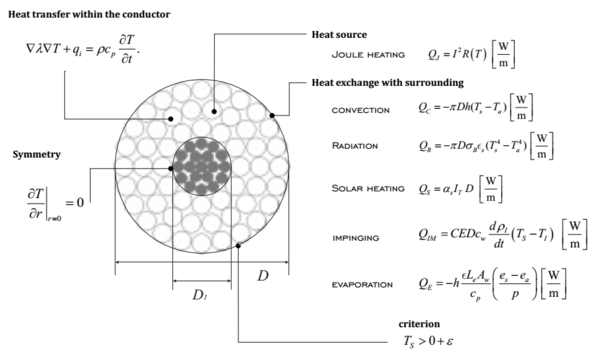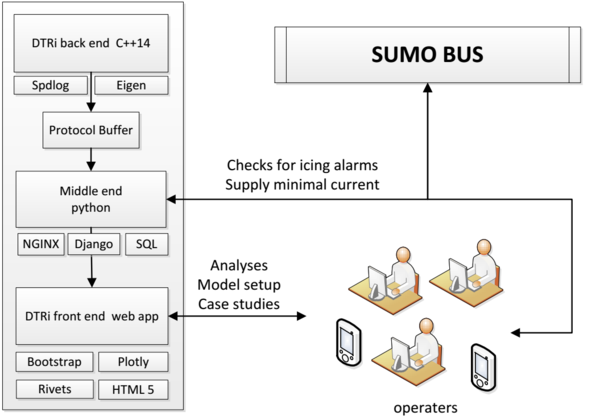Difference between revisions of "Dynamic Thermal Rating of over head lines"
| Line 1: | Line 1: | ||
| − | In February 2014 a severe icing storm hit Slovenia, and caused damage in order of 8.5 million € only on the power transmission network. | + | In February 2014 a severe icing storm hit Slovenia, and caused damage in order of 8.5 million € only on the power transmission network. Based on feasibility study performed by Jožef Stefan Institute (JSI), Milan Vidmar Electric Power Research Institute (EIMV), Slovenian Environment Agency (SEA), and ELES, which confirmed that using Joule heating could prevent icing JSI further developed an operative software termed DTRi (Dynamic Thermal Rating - icing). The core of the DTRi is a physical model for the simulation of heat transfer within the transmission power line under realistic weather conditions related to the icing, i.e., ambient temperatures between -5 oC and 5 oC with super cooled rain present. The DTRi comprises the Joule heating, convection, solar heating, evaporation, radiation and impinging super cooled precipitation. Basically, the DTRi solves the heat transport equation (second order partial differential equation) with non-linear boundary conditions describing different heat terms due to the weather conditions. The results obtained with DTRi have been compared against available published data as well as measurements provided by EIMV, with promising results. |
| + | DTRi can run in two modes, i.e. as standalone software and as an embedded system within the SUMO framework, which is a heterogeneous collection of subsystem from different vendors that was developed to increase safety and security as well as the capacity of the existing transmission network. Its core is the integration platform, SUMO BUS, which is an enterprise integration bus, used for orchestrating the subsystems and facilitating data exchange between them. The communication between SUMO BUS and the subsystems is based on web services. More precisely subsystems communicate with the bus via SOAP/HTTP interfaces. This technology enables different subsystem vendors to quickly and efficiently connect their subsystems using standardized and open means of communication and exchanging data. For example, SUMO allows different Dynamic Thermal Rating (DTR) vendors to be incorporated into the system, each serving a different part of the grid. Currently there are 17 services implemented. They are providing approximately 115 methods to the clients (subsystems). System’s internal state is held in a relational SQL database. | ||
| − | + | More details can be found in user manual of the DTRi package [[:File:manual.pdf]] | |
<table> | <table> | ||
<tr><td> | <tr><td> | ||
Revision as of 22:26, 20 October 2016
In February 2014 a severe icing storm hit Slovenia, and caused damage in order of 8.5 million € only on the power transmission network. Based on feasibility study performed by Jožef Stefan Institute (JSI), Milan Vidmar Electric Power Research Institute (EIMV), Slovenian Environment Agency (SEA), and ELES, which confirmed that using Joule heating could prevent icing JSI further developed an operative software termed DTRi (Dynamic Thermal Rating - icing). The core of the DTRi is a physical model for the simulation of heat transfer within the transmission power line under realistic weather conditions related to the icing, i.e., ambient temperatures between -5 oC and 5 oC with super cooled rain present. The DTRi comprises the Joule heating, convection, solar heating, evaporation, radiation and impinging super cooled precipitation. Basically, the DTRi solves the heat transport equation (second order partial differential equation) with non-linear boundary conditions describing different heat terms due to the weather conditions. The results obtained with DTRi have been compared against available published data as well as measurements provided by EIMV, with promising results. DTRi can run in two modes, i.e. as standalone software and as an embedded system within the SUMO framework, which is a heterogeneous collection of subsystem from different vendors that was developed to increase safety and security as well as the capacity of the existing transmission network. Its core is the integration platform, SUMO BUS, which is an enterprise integration bus, used for orchestrating the subsystems and facilitating data exchange between them. The communication between SUMO BUS and the subsystems is based on web services. More precisely subsystems communicate with the bus via SOAP/HTTP interfaces. This technology enables different subsystem vendors to quickly and efficiently connect their subsystems using standardized and open means of communication and exchanging data. For example, SUMO allows different Dynamic Thermal Rating (DTR) vendors to be incorporated into the system, each serving a different part of the grid. Currently there are 17 services implemented. They are providing approximately 115 methods to the clients (subsystems). System’s internal state is held in a relational SQL database.
More details can be found in user manual of the DTRi package File:manual.pdf

